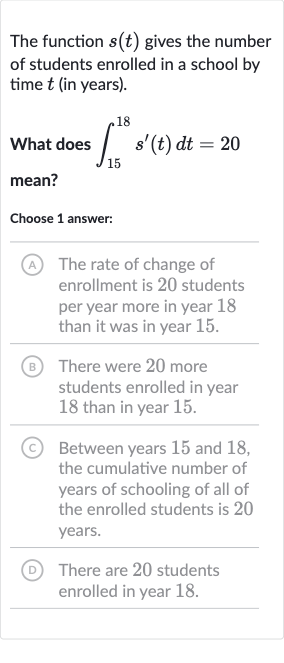AI tutor
Welcome to Bytelearn!
Let’s check out your problem:

The function gives the number of students enrolled in a school by time (in years).What does mean?Choose answer:(A) The rate of change of enrollment is students per year more in year than it was in year .(B) There were more students enrolled in year than in year .(C) Between years and , the cumulative number of years of schooling of all of the enrolled students is years.(D) There are students enrolled in year .
Full solution
Q. The function gives the number of students enrolled in a school by time (in years).What does mean?Choose answer:(A) The rate of change of enrollment is students per year more in year than it was in year .(B) There were more students enrolled in year than in year .(C) Between years and , the cumulative number of years of schooling of all of the enrolled students is years.(D) There are students enrolled in year .
- Concept Explanation: The integral of the derivative of a function over an interval gives the net change in the function's value over that interval. In this case, the function represents the number of students enrolled in a school at time . The derivative represents the rate of change of the number of students with respect to time.
- Integral Calculation: By integrating from to , we are finding the total change in the number of students from year to year . Since the integral is equal to , this means that there is a net increase of students over this time period.
- Analysis of Answer Choices: Now we need to match this interpretation with the correct answer choice. The integral does not give us information about the rate of change per year, so option (A) is incorrect. Option (C) is incorrect because the integral does not represent cumulative years of schooling. Option (D) is incorrect because the integral does not tell us the total number of students enrolled in year , but rather the change in enrollment between years and .
- Correct Interpretation: The correct interpretation is that there were more students enrolled in year than in year , which corresponds to option (B). This is because the integral of the rate of change of enrollment from year to year equals , indicating the net increase in enrollment over that period.
